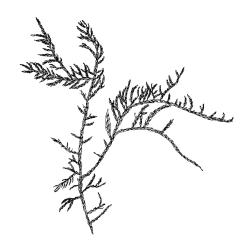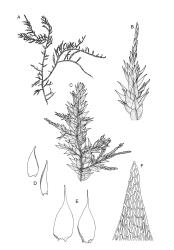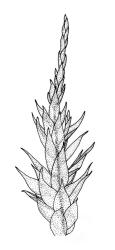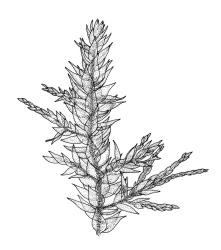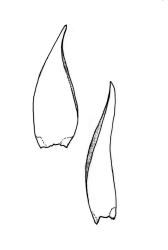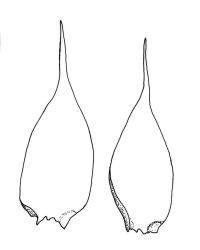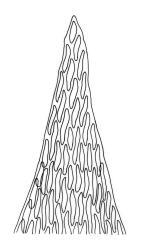Plants yellow-green or golden, medium-sized, forming loosely interwoven mats, with numerous erect and flagelliform branches. Stems creeping, irregularly or subpinnately (never bipinnately) branched, to at least 40 mm, otherwise as per species. Branches simple and erect or curving upwards from the substrate, irregularly (never pinnately) branched, weakly cuspidate and with numerous flagelliform and microphyllous branchlets near tips. Stem and branch leaves differentiated. Stem leaves rather abruptly tapered from a broadly ovate base to a narrowly acuminate apex, best developed near stem apex, entire or weakly and obtusely denticulate above, 1.2–1.4 × 0.4–0.5 mm (under cover slip); mid laminal cells (upper third of leaf) mostly 42–54(–60) × c. 5 µm, firm-walled, smooth or weakly prorate, lacking pores, otherwise as per species; basal cells as per species; alar cells highly differentiated, 3–4 cells highly inflated and thin-walled in the basal row, with 3–4 cells above strongly inflated but slightly smaller and with several irregular supra-alar cells. Branch leaves smaller, ovate-lanceolate, ± evenly tapered to an acute apex, entire or crenulate near apex, mostly 0.7–0.8(–1.1) × 0.2–0.35 mm (under cover slip); mid laminal cells (upper third of leaf) 38–54 × c. 6 µm, not porose, smooth or with low seriate papillae on abaxial surface, otherwise as per species; alar cells as per species.
Apparently dioicous. Sex organs and sporophytes not seen.
Ramsay et al. 2002, fig. 4 e-f (as Wijkia extenuata).
When poorly developed, this taxon is not always possible to distinguish from Sematophyllum subhumile var. contiguum. The present taxon is dioicous and is not known to fruit, while N.Z. material of S. subhumile var. contiguum is autoicous and collections of it usually bear at least some fruit. Microphyllous branches are not produced in Sematophyllum subhumile var. contiguum.
K; NI: N Auckland (Whangaruru North Head, Hukatere, Leigh) including offshore islands (GB), S Auckland (Mercury Bay, near Coromandel, Te Kauri Park Scenic Reserve, Whale I.), Gisborne (Raukokore River, Waihau Bay) SI: Nelson (Little Wanganui River, Lake Hanlon, Punakaikī).
Australasian. Mainland Australia (N.S.W.)*.
Epiphytic on tree trunks (including Aristotelia serrata, Metrosideros kermadecensis, Myoporum laetum, Vitex lucens, and Cordyline australis) and on firm logs. Apparently also terrestrial on Kermadecs, where collections by W.R. Sykes and P. de Lange are from a variety of habitats including open Metrosideros forest, old taro plantation areas, and Mysore thorn (Caesalpinia decapetala) scrub. Frequently associated species include Rhaphidorrhynchium amoenum, Thuidiopsis sparsa, Bazzania adnexa, Heteroscyphus coalitus, and Jamesoniella monodon. From near sea level to 518 m (at the summit of Moumoukai Peak on Raoul I., Kermadec Is), to c. 120 m on both Whale I. and the South I. (Little Wanganui River).
While the variation of W. extenuata s.l. in N.Z. is protean, the continued recognition of only a single taxon (Sainsbury 1955; Fife 1995) obscured this distinctive, morphologically homogenous, and widespread variety. The presence of flagelliform branchlets is frequent in the genus Wijkia and has been used as a taxonomic feature to define Wijkia species in other parts of the world (Buck 1986), but it has not been utilised taxonomically in Australasia. Flagelliform branchlets in W. extenuata occur predominantly in the northern regions of N.Z., and are correlated with relatively weak differentiation between stem and branch leaf shapes, an absence of bipinnate branching, entire or crenulate branch leaf margins, and lack of pores in mid laminal cells of the branch leaves. Branch leaves here can either bear low seriate papillae or appear smooth.
The correlation of these four morphological features justifies the segregation of the variety. While caudate and non-caudate populations of W. extenuata s.l. have distributional overlap on the North and South Is, on the Kermadec Is only the caudate variety occurs; this distributional feature provides further support for recognition of var. caudata. The variety is restricted to areas of marked coastal influence.
Sainsbury (1955) was familiar with the variety and referred to "a curious flagelliferous form [that] occurs in the Bay of Plenty and [which] has been reported from a few littoral stations there". Sainsbury (1955, p. 461) described this plant as "very small and the branching unipinnate, with branches 1 cm long or less from which are produced crowded, flagellate, julaceous and fragile shoots clothed with squamose leaves". Subsequent collections have shown this taxon to be more widespread than Sainsbury knew.
Two collections of the var. caudata have been seen from mainland Australia (N.S.W.) and partial habits of it have been published by Ramsay et al. (2002, fig. 4 e-f).



